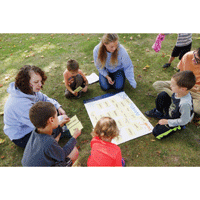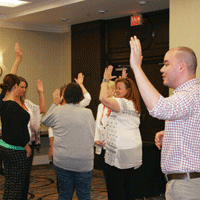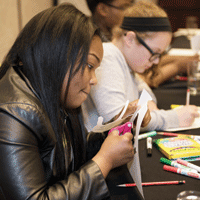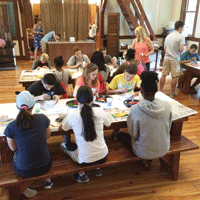Running a local chapter for the bleeding disorders community is no easy task. Most of the National Hemophilia Foundation’s (NHF’s) 51 chapters nationwide have a single staff leader and rely on a cadre of dedicated volunteers. Together they tackle an inventory of responsibilities: organizing regular meetings, fundraising, advocacy and planning retreats. They also provide outreach activities such as camps, education classes and financial assistance. Then there’s the behind-the-scenes tasks, like supplying food for gatherings and overseeing the chapter’s business aspects.
Now, NHF is sending a powerful message of solidarity and support to those chapter leaders, staff members and volunteers: We’re here to help. Over the last year, NHF has been expanding staff and boosting its capacity in the field, visiting chapters and facilitating activities in partnership with local staff. According to Joe Kleiber, senior vice president for chapter services, this effort stems from a challenge issued by NHF CEO Val D. Bias, a longtime member of the chapter community himself. Bias encouraged the organization to offer programs that chapters could easily implement.
“The goal is to expand resources available to chapters, with very little effort and planning on their part,” explains Kristi Harvey-Simi, former executive director of the Nebraska Chapter of NHF before joining NHF headquarters as manager of chapter development. All the chapter leaders have to do is ask for help.
Enhanced resources span three key areas: education, chapter development and advocacy.
Expanding Education

At the Education for Empowerment session,
“Playing It Safe for Kids,” NYLI members
Marlee Whetten (left) and Victoria Baker
(right) teach kids about safe activity choices.
Ensuring that people with bleeding disorders live better lives through direct education is a top priority for NHF this year. In the past, these offerings were mostly online, such as the Steps for Living website, which has age-specific information at various life stages. “We continue to provide excellent resources on the website, but our renewed focus is providing programs on the ground,” explains Dawn Rotellini, VP of chapter development and education.
“We know it’s hard for smaller staffed chapters to facilitate activities,” says Kate Nammacher, MPH, director of education. “Now, we’re sending NHF staff to facilitate workshops and trainings.”
And that staff is highly qualified to help. Several members of the education team hold a master’s degree in public health. “They really understand how you create a true needs assessment and have measurable outcomes,” says Rotellini. Also on staff is Felix Olaya, a bilingual education specialist. He was hired in 2015 to ensure NHF is serving the needs of the Spanish-speaking community and providing a diverse cultural viewpoint.
Best of all, the educational content is driven by the people who will use it. “It’s not just NHF dictating what people should be learning,” Nammacher notes. “We really are engaging the community to understand its educational needs.”
A sampling of new programs includes:
Collaborating in Care. This series of six modules addresses quality-of-life issues and psychosocial concerns of individuals with hemophilia and their families. It stems from the HERO (Haemophilia Experiences, Results and Opportunities) Study, conducted by Novo Nordisk. The needs identified in the resulting data formed the basis of the Collaborating in Care educational modules, which are funded by Novo Nordisk and developed by NHF. Topics include “Communicating with Your Provider About Pain,” “Getting Unstuck: Overcoming Roadblocks to Intimacy and Relationships” and “Out of the Woods: Skills for Coping with Anxiety and Depression.”
Education for Empowerment. This program’s content is driven by needs assessments of the community, explains Rotellini. It tends to be hands-on and interactive, often using panel discussions, games and art. Examples of sessions include “Off to College,” which addresses the challenges young adults face, and “Playing It Safe for Kids,” covering how to safely participate in activities and sports. An interactive talk show for siblings helps them articulate their feelings in a safe, fun environment and a mother-daughter session discusses puberty and menstruation issues.
Artistically Speaking. Last spring, Olivia Tousius, then a program coordinator and social worker at Bleeding Disorders Alliance Illinois, scheduled an Artistically Speaking program for teens ages 14 to 17. The unique program, which uses art therapy techniques to talk about bleeding disorders, is also offered to young adults and couples. There are plans to offer it to women as well. “I had heard that NHF was doing a lot of educational supplemental programming,” Tousius says. “They were easy to work with, and very professional.”
Sarah Watson, MA, licensed professional counselor, was brought in to facilitate the program in Illinois. In some sessions Watson asks participants to make masks that depict their feelings—how they present their feelings on the outside versus what’s going on inside. Following the exercise, she works with the group as a whole. “It’s really interesting to have these kids talk about how a bleeding disorder has affected them and see how they learn from others,” she says.
“It was a small group of kids, but all were super engaged,” says Tousius. “That, to me, is a success.”

Felix Olaya (right) teaches a group of
chapter staff an ice breaker at a Train
the Trainer workshop.
Artistically Speaking workshops were also held in North Carolina and Michigan this fall. “I’m willing to adapt whatever exercise for whatever the chapter needs,” Watson says. “Art is an important tool for our community to use, and it’s beneficial.”
Work for You. The program offers four 90-minute workshops to help adults navigate career issues. Topics can also help teens looking for their first job or retirees embarking on a second career. Launched last spring, the workshops comprise: “Work-Life Balance: Walking the Tight Rope,” “Your Dream Job: What Makes a Good Career Fit,” “Career Management: Being Entrepreneurial About Your Career” and “Job Search Basics: What You Need to Know to Get a Job.”
This education is especially timely for those with bleeding disorders. “Starting at the teenage years, the first thing you’re told is, ‘You need to go out and get a job with insurance,’” Rotellini says.
Lisa Orbé-Austin, PhD, is a career psychologist who leads Work for You sessions at NHF chapters. “Given the nature of bleeding disorders, there’s a lot to think about in terms of what careers may be a good fit, what benefits you need and the jobs you choose,” she explains. Further, your career often shapes your identity. “Many people don’t realize how important it is until they lose a job or find themselves in long-term unemployment,” she says.
Helping Chapters Grow

A participant at the Artistically Speaking
workshop in Chicago is engrossed in
her task.
NHF is also educating chapter leaders in managing their organizations via:
Programming training. As a chapter leader, one of the primary challenges is developing engaging content and activities for each meeting, retreat and conference. The Steps for Living Train the Trainer educational program helps leaders do just that. This three-day, in-person workshop shows chapter staff how to facilitate activities and discussions. It also shows them how to organize logistics, deal with conflict and keep people engaged. Participants walk away with a 150-page, step-by-step reference guide.
Before Train the Trainer, Harvey-Simi recalls that her Nebraska chapter struggled to involve young people. “They go to school every day, so to have them listen to a lecture was not attracting them.” The program armed the leaders with ideas for fun, interactive sessions, such as a Family Feud-style game called Factor Feud. It was a resounding success, Harvey-Simi says. “After that, they were interactive, laughing and sharing stories.”
Financial support. NHF works with chapters to connect them with grant opportunities that can make a world of difference, says Kleiber. “A number of chapters now have their first full-time director solely due to capacity-building grants provided by NHF.” Increased financial support also encourages new chapter formation. “Over the last eight years, we’ve gone from 34 to 51 chapters, a 50% increase,” he says.
Organizational training. Two regional leadership seminars are planned each year, and there were 20 board development retreats this year alone, says Kleiber. Rotellini cites additional examples of direct chapter support, through chapter trainings with expert speakers. “For 2016, we plan to continue to grow, to offer more to chapters,” says Rotellini. Those offerings include regional trainings in the spring that will cover how to create a youth development leadership program, addressing how teens and young adults think, and how best to engage them.
Making Advocacy Easier

Sarah Watson facilitated an Artistically
Speaking workshop for teens at a
Hemophilia of South Carolina event.One visible result of a chapter’s success is advocating for the needs of those with bleeding disorders on state and local issues. “We provide technical assistance and training to clearly identify what the issues are in their state and what is the appropriate arena to address those issues,” says Michelle Rice, VP of public policy and stakeholder relations. The main focus, she says, is to improve local leaders’ comfort with these activities.
Much has changed in the public policy arena since the Affordable Care Act was passed in 2010. The focus used to be on advocating for federal laws. “Now, healthcare is a state game,” says Jennifer M. Guy, JD, government relations manager. That means members of the bleeding disorders community have to prioritize staying on top of state laws and building relationships with state legislators, insurance executives and Medicaid directors.
NHF is supporting chapters in advocacy by offering:
More staff support. NHF’s public policy team has been rapidly expanding and offering field support. “There are six on the team, and three of those are dedicated to going out to chapters,” Rice says.
“Advocacy day in a box.” Many chapters hold an advocacy day, during which volunteers meet with elected officials to educate them about hemophilia and other bleeding disorders. Because it’s easy to get intimidated by such an undertaking, NHF created what Guy calls “advocacy day in a box.” It’s a series of 18 tools to guide chapter staff and volunteers in organizing an advocacy day and managing the workload.
When the Hemophilia Foundation of Oregon in Corvallis was ready to hold its first advocacy day, it turned to NHF for support. “I had some idea of what it should look like, but NHF helped us lay the groundwork for our first visit to the capital,” says executive director Madonna McGuire Smith.
Before the event, NHF hosted two webinars for the chapter staff and organized mailings to state legislators about key bills. The day before the visit to the capital in Salem, NHF experts worked with volunteers on how to convey their personal experiences to legislators. “Volunteer advocates have these stories, but haven’t been taught how to attach their story to particular policy issues,” Guy explains. The Oregon chapter’s advocacy day was a success, with a group of 70 meeting with more than 40 legislators. “It was a very educational day all around,” Smith says.
Strategic planning for advocacy. “Having an impact on policy starts way before a bill is heard in committee, voted on and signed,” Guy notes. That’s why NHF offers overall strategic planning for chapter advocacy activities. A two-hour onsite workshop helps chapters identify key policy priorities and objectives. Further, it introduces them to setting up an advocacy committee to support those objectives. “We either bring in an outside consultant or we lead a strategic planning session ourselves,” says Rice. The focus is on how to develop a year-round advocacy plan, not just a legislative day once a year, she adds. For chapter leaders who hunger for more, NHF has rolled out the patient advocacy, saving, surviving, inspiring, organizing, nurturing (PASSION) program. It’s an in-person training that consists of four 90-minute modules offered onsite. Evaluating and monitoring state legislation is covered, as well as how to interact with legislators. Since the program launched in the spring, more than 20 NHF chapters have been trained.
Regional advocacy centers. Another effort that is reaping rewards is establishing regional advocacy centers in states that have multiple chapters. “It’s important to talk with one voice,” Rice says. NHF has aided chapters by providing financial and technical assistance to hire a coordinator or pay for a consultant. In other cases, it helped create a website to interact better with community members.
The two Texas chapters that came together and collaborated with NHF on a strategic planning process are a good example of a regional advocacy center. They identified what they should be doing and whom they should be communicating with to help them gain a recognized presence in the state. Their coordinated efforts paid off. “Three bills got passed that year, which is unheard of,” says Rice.
NHF’s renewed focus on supporting chapters ultimately helps everyone in the bleeding disorders community. When chapters are strong—offering meaningful education programs, improving management of their organizations, and advocating for positive changes at the state and local level—those with bleeding disorders and their families are better served. And that’s the reason NHF exists.

